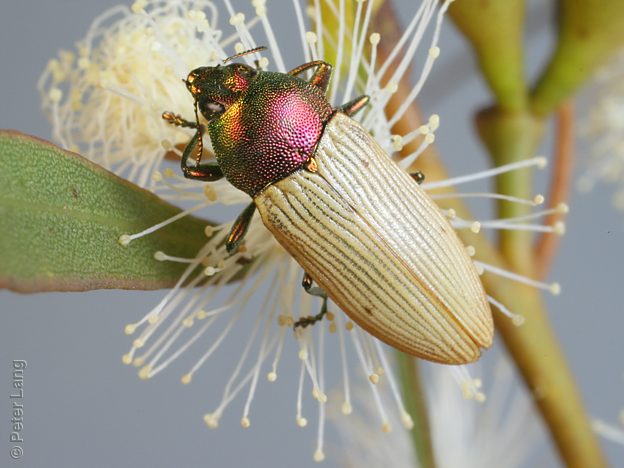
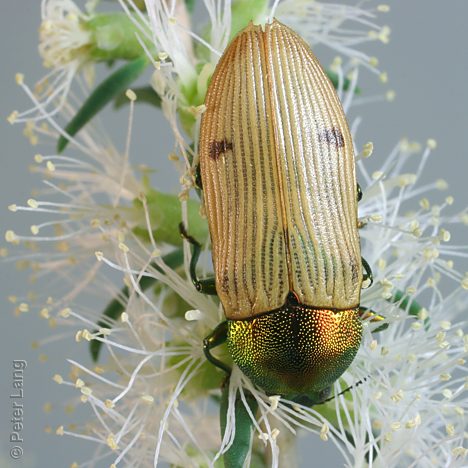
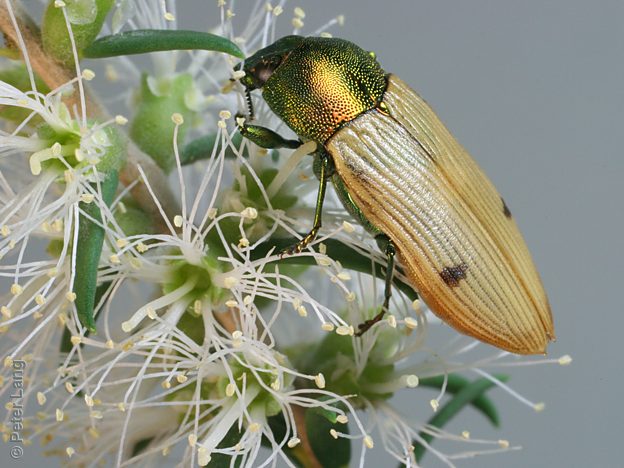
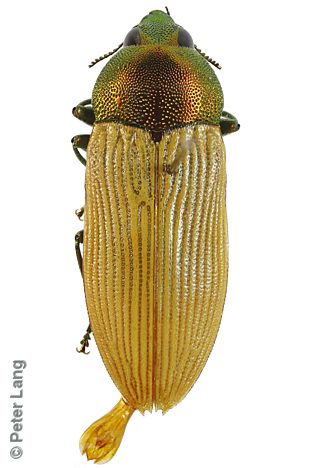
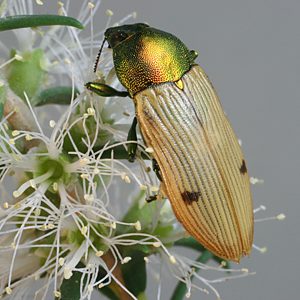
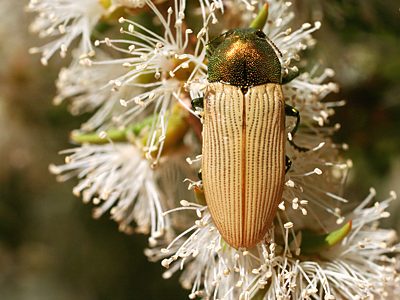
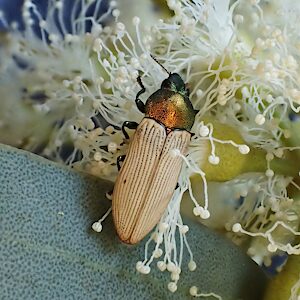
size¹:
×
4.3 mm







| male | female | |||||
|---|---|---|---|---|---|---|
| L1 | 11.7 | 10.3 – 12.35 | n = 9 | 12.7 | 11.3 – 14 | n = 6 |
| L2 | 11.3 | 10 – 11.9 | n = 6 | 12.4 | 11.05 – 13.4 | n = 5 |
| W | 4.1 | 3.7 – 4.4 | n = 9 | 4.6 | 3.95 – 5.95 | n = 6 |
| Legend | L1 | length from clypeus/frons to elytral apex (mean, range, sample size) |
| L2 | length from anterior of edge of eyes to elytral apex | |
| W | maximum width with elytra fully closed |
Head and pronotum metallic golden-green to bronze or reddish; elytra straw-coloured, usually with a pair of brownish spots in the posterior half that are variable in size (and from which it gets its name notata, meaning 'marked'), or the spots sometimes absent. The ventral side has the abdomen entirely testaceous (light translucent-brown and non-metallic) in both males and females. Superficially very similar to C. pallidipennis, but that belongs in another species group and is distinguishable by its more rounded body shape and the abdomen ventrally metallic in females. Also similar to the slightly larger C. subtincta which has elytra darkened to orange towards their apices, males with only the last three ventral abdominal segments testaceous and the females entirely metallic green ventrally.
A summer-emerging species that can be very abundant in the blossoms of summer-flowering Mallee Eucalypt species and Dryland Tea-tree Melaleuca lanceolata. Its predominantly yellowish colouration pattern is typical of a number of summer-emerging Buprestid species that are adapted to feeding in Eucalypt flowers, including the closely related C. subtincta, as well as C. pallidipennis and C. flava which belong to different species groups.
| Legend | P.J.Lang collection vouchered records | |
| other private collection or museum specimens, or sightings |
|
|
|
|
|
|
|
|
|
|
|
|
|
||||||||||||||||||||||||||||||||||||||||||||||||
|
|
|
|
|
|
|
|
|
|
|
|
|
||||||||||||||||||||||||||||||||||||||||||||||||
| Jul | Aug | Sep | Oct | Nov | Dec | Jan | Feb | Mar | Apr | May | Jun |
| Legend | live emerged adults, count > median value of 24 per quarter month | |
| live emerged adults, count <= median value of 24 | ||
| live non-emerged adults only, for that quarter month | ||
12 | number of active beetles for that quarter month |
| beetles | sites | SA regions¹ | family | position on host plant | |||
| Eucalyptus leptophylla | 133 | 14 | EP, MU, SE | M | |||
| Melaleuca lanceolata | 34 | 7 | EP, MU | M | |||
| Eucalyptus brachycalyx | 8 | 1 | EP | M | |||
| Eucalyptus dumosa | 1 | 1 | EP | M | |||
| Eucalyptus phenax ssp. phenax | 1 | 1 | EP | M | |||
| Eucalyptus socialis ssp. socialis | 1 | 1 | MU | M | |||
| Eucalyptus sp. | 1 | 1 | MU | M |
| Legend | beetles | count of beetles collected from, or sighted on, host plant taxon |
| sites | count of major sites (unique 10 km grid cells +/- some distinct approximate localities) | |
| Plant names in green are hyperlinked to a matching host species page with plant photos. | ||
| Code | beetles | % | host plant taxa | |
| M | Myrtaceae | 179 | 100% | 6 |
| position | beetles | sites | |
| on flower(s) | 24 | 8 | |
| on flowering plant | 155 | 13 |
| ¹ Legend | regions | SA State Herbarium regions (map) EA: Eastern, EP: Eyre Peninsula, FR: Flinders Ranges, GT: Gairdner-Torrens, KI: Kangaroo Island, LE: Lake Eyre, MU: Murray, NL: Northern Lofty, NU: Nullarbor, NW: North-Western, SE: South-Eastern, SL: Southern Lofty, YP: Yorke Peninsula |
| size | The ellipse is the correct size when printed, indicative on a desktop screen, and likely to be wrong on a mobile device. |